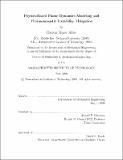| dc.contributor.advisor | Ahmed F. Ghoniem. | en_US |
| dc.contributor.author | Altay, Hurrem Murat | en_US |
| dc.contributor.other | Massachusetts Institute of Technology. Dept. of Mechanical Engineering. | en_US |
| dc.date.accessioned | 2009-11-06T14:51:41Z | |
| dc.date.available | 2009-11-06T14:51:41Z | |
| dc.date.copyright | 2009 | en_US |
| dc.date.issued | 2009 | en_US |
| dc.identifier.uri | http://hdl.handle.net/1721.1/49558 | |
| dc.description | Thesis (Ph. D.)--Massachusetts Institute of Technology, Dept. of Mechanical Engineering, 2009. | en_US |
| dc.description | This electronic version was submitted by the student author. The certified thesis is available in the Institute Archives and Special Collections. | en_US |
| dc.description | Includes bibliographical references (p. 183-193). | en_US |
| dc.description.abstract | The objectives of this work are (i) to investigate the coupled unsteady heat release mechanisms responsible for thermoacoustic instabilities under different flame anchoring configurations, (ii) to develop reduced-order models to predict the dynamic flame response, and (iii) to develop passive instability mitigation strategies by modifying the dynamics of the flame anchoring zone. The two different anchoring configurations investigated were the wake-stabilized flames and the perforated-plate stabilized flames. In order to investigate the wake-stabilized flames, experiments were performed in an atmospheric pressure, backward-facing step combustor. In this configuration, the dynamics are primarily governed by the flame-vortex interactions, whereas the equivalence ratio oscillations have minor impacts. Depending on the equivalence ratio, inlet temperature and the fuel composition, the combustor operates under different dynamic modes. The operating conditions at the transition between different modes were predicted by developing a model based on the acoustic and vortex time scales. A passive control strategy involving injection of steady air ow near the step in the cross-stream or streamwise directions were tested. Both injection configurations were able to suppress the instability under some operating conditions at which the unsteady interactions between the flame and the wake vortex were eliminated. The cross-stream air injection method eliminates these interactions by generating a new, steady recirculation zone upstream of the step. On the other hand, the streamwise air injection method eliminates these interactions by directly stabilizing the ow dynamics in the unsteady recirculation zone. | en_US |
| dc.description.abstract | (cont.) In order to investigate the perforated-plate stabilized flame dynamics, a theoretical model was developed to predict the dynamic heat-release response to inlet velocity oscillations. In this configuration, the dynamics are driven by the coupled effects of the flame-wall interactions and the flame-acoustic wave interactions, generating burning velocity and flame area oscillations. The model predictions under different operating conditions were compared with the experiments and good agreement was obtained. As the heat loss to the plate increases, the plate's surface temperature rises, the flame temperature decreases, and the burning velocity oscillations become more significant. In order to verify and relax some model assumptions, two-dimensional simulations were performed in the same configuration utilizing a detailed chemical kinetic mechanism and allowing the heat transfer between the gas and the perforated-plate. The primary results of the simulations support the conclusions of the theoretical model, and show the significant impact of the heat transfer to the plate on both the steady flame characteristics, and the unsteady dynamic flame response. | en_US |
| dc.description.statementofresponsibility | by Hürrem Murat Altay. | en_US |
| dc.format.extent | 193 p. | en_US |
| dc.language.iso | eng | en_US |
| dc.publisher | Massachusetts Institute of Technology | en_US |
| dc.rights | M.I.T. theses are protected by
copyright. They may be viewed from this source for any purpose, but
reproduction or distribution in any format is prohibited without written
permission. See provided URL for inquiries about permission. | en_US |
| dc.rights.uri | http://dspace.mit.edu/handle/1721.1/7582 | en_US |
| dc.subject | Mechanical Engineering. | en_US |
| dc.title | Physics-based flame dynamics modeling and thermoacoustic instability mitigation | en_US |
| dc.type | Thesis | en_US |
| dc.description.degree | Ph.D. | en_US |
| dc.contributor.department | Massachusetts Institute of Technology. Department of Mechanical Engineering | |
| dc.identifier.oclc | 456740537 | en_US |
